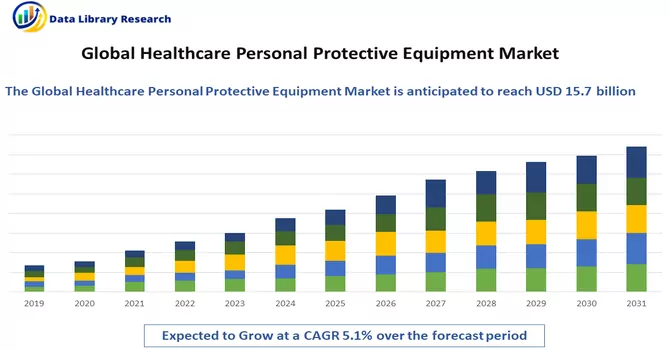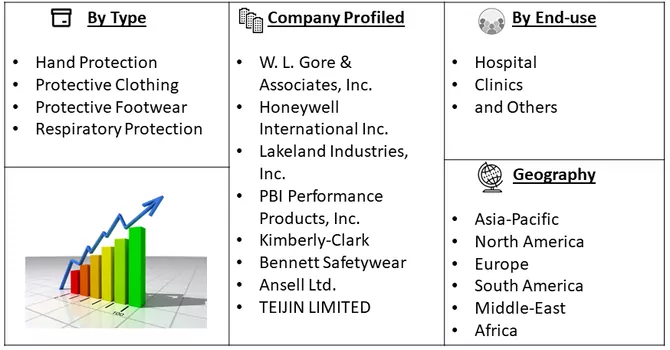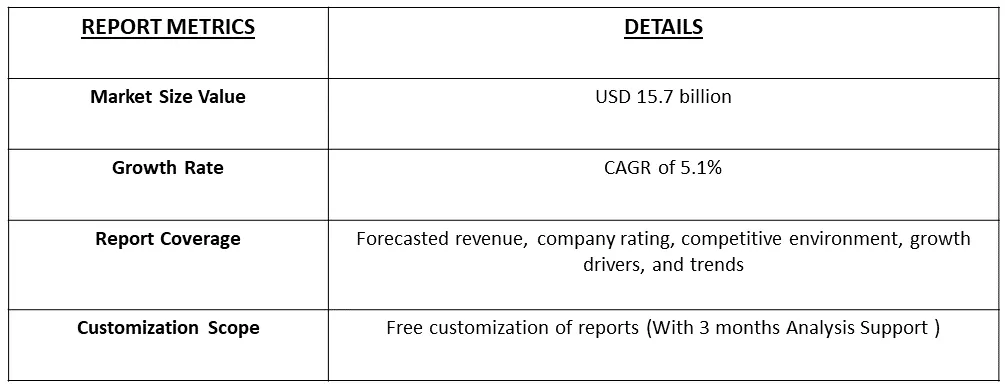The global healthcare personal protective equipment market size was valued at USD 15.7 billion in 2023 and is expected to grow at a compound annual growth rate of 5.1% over the forecast period, 2024-2031.

Get Complete Analysis Of The Report - Download Free Sample PDF
Healthcare personal protective equipment (PPE) plays a pivotal role in creating a secure environment for healthcare professionals and patients worldwide. The extensive range of PPE includes disposable gloves, various masks (such as respirators and surgical masks), eye protection (like goggles or face shields), gowns and aprons, head coverings, foot coverings, and specialized respirators like N95 masks. Together, these components constitute a robust defense mechanism, effectively mitigating the transmission of infections. They act as a barrier, shielding healthcare workers from direct contact with pathogens and preventing the dissemination of airborne particles and droplets. The proper utilization, correct disposal practices, and adherence to established standards and guidelines are essential to uphold a safe healthcare environment, particularly during pandemics or outbreaks. This ensures the collective well-being of both healthcare workers and patients by minimizing the risk of contagion and maintaining stringent safety measures.
The Healthcare Personal Protective Equipment (PPE) market is propelled by several key drivers. The heightened global awareness and emphasis on infection prevention, particularly in the context of rising infectious diseases and pandemics like COVID-19, contribute significantly to the increasing demand for PPE. Stringent regulatory guidelines mandating the use of protective gear in healthcare settings, coupled with continuous advancements in PPE technology and materials, drive innovation within the market. The expansion of global healthcare infrastructure, a growing focus on occupational safety for healthcare workers, and the need for stockpiling PPE to address potential health crises further fuel the market. Additionally, increased public awareness about the role of PPE in preventing the spread of infections contributes to the sustained demand for these protective solutions, creating a dynamic and evolving market landscape.
Several market trends are shaping the landscape of the Healthcare Personal Protective Equipment (PPE) market. Firstly, the integration of advanced technologies, such as smart sensors and wearable devices, into PPE is gaining traction, enhancing monitoring capabilities and ensuring better compliance with safety protocols. Secondly, sustainability is becoming a prominent trend, with a growing emphasis on eco-friendly and recyclable materials in PPE manufacturing, aligning with broader environmental consciousness. Additionally, the market is witnessing an increased focus on ergonomics and user comfort, as manufacturers strive to design PPE that is not only effective in protection but also more wearable for extended periods, addressing concerns about user fatigue. Customization of PPE to cater to specific healthcare settings and diverse user needs is another notable trend, reflecting the recognition that one-size-fits-all solutions may not be optimal for various healthcare scenarios. Moreover, the globalization of supply chains and the diversification of PPE sourcing are becoming key trends, driven by the lessons learned during global health crises. This includes efforts to reduce dependence on a single source and ensure a more resilient and responsive supply chain for PPE. The rise of e-commerce platforms for PPE procurement is also reshaping distribution channels, offering convenience and efficiency in accessing protective equipment. Furthermore, continuous research and development in nanotechnology and antimicrobial coatings for PPE materials are enhancing the effectiveness of protective gear against pathogens. The market is also witnessing an increased demand for reusable PPE options, promoting cost-efficiency and addressing concerns related to waste management. Finally, ongoing collaborations between industry players and healthcare organizations, along with strategic partnerships, are fostering innovation and creating a more competitive market landscape. As the healthcare sector continues to evolve, these trends collectively contribute to the dynamic nature of the Healthcare PPE market, influencing product development, adoption, and overall market growth.
Market Segmentation: The Healthcare Personal Protective Equipment (PPE) market is Segmented Type (Hand Protection, Protective Clothing, Protective Footwear, Respiratory Protection), End User (Hospital, Clinics, and Others) and Geography (North America, Europe, Asia-Pacific, South America, and Middle East and Africa). The market size and forecasts are provided in terms of value (USD million) for all the above segments.

For Detailed Market Segmentation - Download Free Sample PDF
Market Drivers:
Rising healthcare infrastructure
Conversely, evolving consumer preferences and the increased accessibility of advanced healthcare facilities present several opportunities that are poised to drive the growth of the Medical Personal Protective Equipment (PPE) market throughout the forecast period. As consumers become more discerning in their choices, there is a growing demand for PPE solutions that offer enhanced comfort, usability, and innovative features. The expansion of healthcare infrastructure, coupled with a heightened focus on patient safety and well-being, creates a favorable environment for the adoption of advanced PPE technologies. This shift in preferences, combined with the continuous improvement in healthcare services, positions the market to capitalize on emerging opportunities and cater to evolving needs in the healthcare landscape.
Increase in injuries and accidents
The rise in injuries and accidents underscores the critical importance of Medical Personal Protective Equipment (PPE) in mitigating occupational hazards and safeguarding individuals in various industries. Whether in healthcare, construction, manufacturing, or other high-risk sectors, the use of appropriate PPE becomes paramount in preventing injuries and minimizing the severity of accidents. The escalation of injuries, particularly those related to the workplace, necessitates a comprehensive approach to safety, and PPE plays a pivotal role in this strategy. The demand for protective gear such as gloves, helmets, safety goggles, and specialized clothing has surged as organizations and workers prioritize the implementation of stringent safety measures. This heightened awareness of the correlation between accidents and the need for reliable PPE not only emphasizes the importance of a safety-oriented culture but also drives advancements in protective technologies to enhance workplace safety across diverse industries.
Market Restraints:
Lack of awareness
The Medical Personal Protective Equipment (PPE) market may encounter obstacles to its growth throughout the forecast period, particularly stemming from a notable lack of awareness in developing economies. The potential impediment arises from a limited understanding or awareness of the significance and proper utilization of medical PPE in these regions. The challenges could extend to educating healthcare professionals, policymakers, and the general public about the critical role of PPE in infection prevention and control. Overcoming this awareness gap becomes crucial for sustained market growth, necessitating targeted efforts to enhance understanding, promote the importance of protective equipment, and ensure its appropriate utilization in healthcare settings within developing economies.
The COVID-19 pandemic has had a profound impact on the Medical Personal Protective Equipment (PPE) market, marked by an unprecedented surge in demand as healthcare facilities and frontline workers grapple with the need for enhanced safety measures. This surge has led to challenges in supply chain management, prompting manufacturers to increase production capacities and innovate to meet the escalating requirements. Governments and regulatory bodies have played a crucial role in shaping the market by implementing stringent guidelines, while technological advancements, such as antiviral coatings and smart PPE, have gained prominence. Collaborations between industry players, governments, and research institutions have also intensified to address supply chain disruptions and ensure a coordinated global response. The pandemic's enduring effects are expected to reshape the PPE industry, fostering increased awareness, innovation, and preparedness for future health crises.
Segmental Analysis:
Protective Clothing Segment is Expected to Witness Significant Growth Over the Forecast Period
The Protective Clothing and Medical Personal Protective Equipment (PPE) market has witnessed significant growth and transformation, fueled by heightened awareness of safety measures and the unprecedented demands arising from global health crises like the COVID-19 pandemic. Protective clothing, including gowns, coveralls, and face shields, has become a critical component in safeguarding healthcare professionals and workers across various industries. The market has experienced a surge in demand for advanced PPE that not only meets regulatory standards but also addresses comfort, breathability, and overall user experience. The COVID-19 pandemic, in particular, has accelerated innovations in protective clothing, leading to the development of antimicrobial fabrics, smart textiles, and disposable yet durable materials. These advancements not only enhance protection against pathogens but also contribute to the overall efficiency and convenience of PPE usage. The market has seen collaborations between textile manufacturers, technology companies, and healthcare institutions to drive research and development in this sector. Additionally, the implementation of strict safety regulations and guidelines by governments and industry bodies has propelled the adoption of PPE in various sectors, further driving the market. The increasing emphasis on employee and healthcare worker safety, coupled with the need for robust infection control measures, has positioned the Protective Clothing and PPE market as a cornerstone in ensuring a secure and resilient environment across diverse industries. As the global focus on health and safety continues to intensify, the Protective Clothing and Medical PPE market is expected to evolve, with ongoing advancements in materials, design, and technology, creating a dynamic landscape that caters to the ever-growing demand for reliable and innovative protective solutions.
Hospital Segment is Expected to Witness Significant Growth Over the Forecast Period
The Hospital and Protective Clothing, as well as the Medical Personal Protective Equipment (PPE) market, have witnessed substantial growth and transformation, propelled by the imperative need for comprehensive safety measures within healthcare settings. Hospitals, as critical frontline institutions in the battle against infectious diseases, have become focal points for the utilization of advanced PPE. The market for protective clothing in hospitals encompasses a wide range of gear such as gowns, masks, gloves, face shields, and coveralls, crucial for safeguarding healthcare professionals and patients. The onset of the COVID-19 pandemic has significantly heightened the demand for PPE in hospitals, prompting innovation and accelerated production to meet the unprecedented requirements. Beyond traditional protective equipment, hospitals are increasingly investing in state-of-the-art technologies, such as smart textiles and antimicrobial coatings, to enhance the effectiveness of PPE in infection prevention. Government regulations and guidelines, in conjunction with the heightened awareness of infection control, have been instrumental in shaping the dynamics of the Hospital and PPE market. Stringent safety measures and the need for a resilient healthcare infrastructure have led to increased adoption of advanced protective clothing, fostering collaborations between healthcare institutions, manufacturers, and technology providers. The Hospital and Protective Clothing market is characterized by a dynamic landscape, driven by ongoing research and development, continuous improvements in PPE design, and the integration of cutting-edge technologies. As the healthcare sector evolves to meet new challenges, the market is poised to play a pivotal role in ensuring the safety of healthcare professionals, patients, and the broader community, emphasizing the critical importance of protective measures in healthcare environments.
North America Region is Expected to Witness Significant Growth Over the Forecast Period
In the North America region, the Hospital and Medical Personal Protective Equipment (PPE) market has experienced significant developments, driven by the imperative to fortify healthcare systems against infectious diseases and enhance safety standards within hospital settings. The COVID-19 pandemic has accentuated the importance of PPE, leading to a substantial surge in demand for protective clothing, masks, gloves, and other equipment in hospitals across the region. North America has witnessed a proactive response from both public and private sectors, with governments implementing stringent guidelines and regulations to ensure the adoption of robust infection control measures. This has propelled hospitals to invest in advanced PPE technologies, including innovative materials, smart textiles, and enhanced designs to provide optimal protection for healthcare professionals and patients. The region's Hospital and PPE market is characterized by a high level of technological innovation, with collaborations between healthcare institutions, research organizations, and manufacturers driving continuous advancements. The emphasis on local production and supply chain resilience has gained prominence, leading to increased manufacturing capabilities to meet the escalating demand for protective gear. Furthermore, the North America region has seen strategic partnerships between government bodies, healthcare organizations, and industry players to establish a coordinated approach to PPE procurement, distribution, and innovation. The market dynamics are shaped by a commitment to maintaining a robust healthcare infrastructure capable of addressing current challenges and future health crises effectively. As the North American Hospital and PPE market evolves, it serves as a critical component in the overall healthcare resilience strategy, emphasizing the significance of reliable and technologically advanced protective measures to ensure the safety of healthcare professionals and the broader community.

Get Complete Analysis Of The Report - Download Free Sample PDF
Market participants are strategically prioritizing integration throughout the value chain as a key approach to gain a competitive edge in the Healthcare Personal Protective Equipment (PPE) market. Beyond integration, companies commonly employ diverse strategies, including the continuous development of new products, forming strategic partnerships, engaging in mergers and acquisitions, and expanding both their product portfolios and distribution networks. Notably, many manufacturers have scaled up their production capacities to meet the heightened demand resulting from the Covid-19 pandemic. In response to the urgent need for PPE during the pandemic, manufacturers are collaborating closely with government authorities and industry partners to ensure the timely supply of critical protective equipment. These multifaceted strategies collectively underscore the dynamic and responsive nature of market players in adapting to evolving market demands and global health challenges. Some prominent players in the global healthcare personal protective equipment market include:
Recent Development:
1) In May 2020, a significant development occurred as the Department of Defense inked a substantial USD 126 million agreement with 3M, aiming to boost the monthly production of 26 million N95 medical-grade masks in response to the escalating COVID-19 outbreak. This collaborative effort involved coordination with the Department of Health and Human Services. Concurrently, 3M had already heightened respirator production in January 2020, doubling its annual output to an impressive 1.1 billion, with a dedicated focus on manufacturing 35 million N95 masks per month within the United States.
2) In July 2020, 3M and researchers from the Massachusetts Institute of Technology (M.I.T.) initiated trials for a pioneering rapid test designed to detect the virus, contributing to the global efforts to combat COVID-19. This collaborative venture marked an accelerated study, aiming to assess the feasibility of mass-producing a user-friendly diagnostic tool capable of delivering highly accurate results within a short timeframe. The joint undertaking between 3M and M.I.T. not only underscored the commitment to innovation and addressing the urgent needs of the pandemic but also highlighted the importance of public-private collaborations in advancing solutions for global health challenges.
Q1. What was the Healthcare Personal Protective Equipment Market size in 2023?
As per Data Library Research Market valued at USD 15.7 billion in 2023.
Q2. At what CAGR is the market projected to grow within the forecast period?
Healthcare Personal Protective Equipment Market is expected to grow at a compound annual growth rate of 5.1% over the forecast period.
Q3. Which region has the largest share of the Healthcare Personal Protective Equipment Market? What are the largest region's market size and growth rate?
North America has the largest share of the market . For detailed insights on the largest region's market size and growth rate request a sample here
Q4. Who are the key players in Healthcare Personal Protective Equipment Market?
Some key players operating in the market include :
Data Library Research are conducted by industry experts who offer insight on industry structure, market segmentations technology assessment and competitive landscape (CL), and penetration, as well as on emerging trends. Their analysis is based on primary interviews (~ 80%) and secondary research (~ 20%) as well as years of professional expertise in their respective industries. Adding to this, by analysing historical trends and current market positions, our analysts predict where the market will be headed for the next five years. Furthermore, the varying trends of segment & categories geographically presented are also studied and the estimated based on the primary & secondary research.
In this particular report from the supply side Data Library Research has conducted primary surveys (interviews) with the key level executives (VP, CEO’s, Marketing Director, Business Development Manager and SOFT) of the companies that active & prominent as well as the midsized organization
FIGURE 1: DLR RESEARH PROCESS

Extensive primary research was conducted to gain a deeper insight of the market and industry performance. The analysis is based on both primary and secondary research as well as years of professional expertise in the respective industries.
In addition to analysing current and historical trends, our analysts predict where the market is headed over the next five years.
It varies by segment for these categories geographically presented in the list of market tables. Speaking about this particular report we have conducted primary surveys (interviews) with the key level executives (VP, CEO’s, Marketing Director, Business Development Manager and many more) of the major players active in the market.
Secondary ResearchSecondary research was mainly used to collect and identify information useful for the extensive, technical, market-oriented, and Friend’s study of the Global Extra Neutral Alcohol. It was also used to obtain key information about major players, market classification and segmentation according to the industry trends, geographical markets, and developments related to the market and technology perspectives. For this study, analysts have gathered information from various credible sources, such as annual reports, sec filings, journals, white papers, SOFT presentations, and company web sites.
Market Size EstimationBoth, top-down and bottom-up approaches were used to estimate and validate the size of the Global market and to estimate the size of various other dependent submarkets in the overall Extra Neutral Alcohol. The key players in the market were identified through secondary research and their market contributions in the respective geographies were determined through primary and secondary research.
Forecast Model
